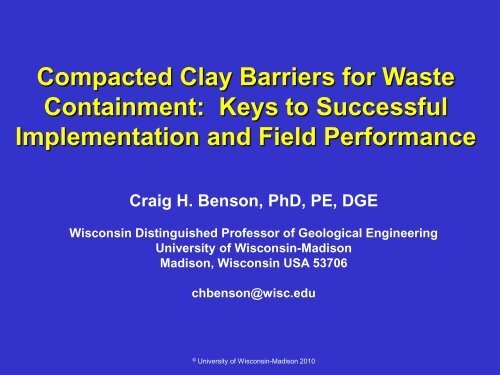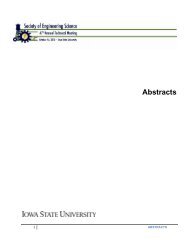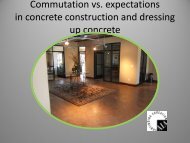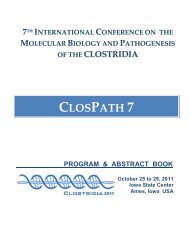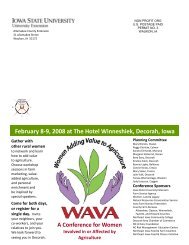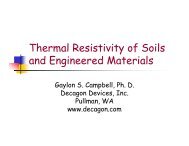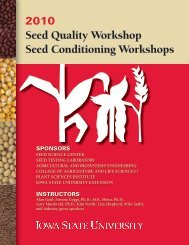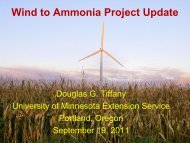Compacted Clay Barriers for Waste Containment: Keys to ...
Compacted Clay Barriers for Waste Containment: Keys to ...
Compacted Clay Barriers for Waste Containment: Keys to ...
You also want an ePaper? Increase the reach of your titles
YUMPU automatically turns print PDFs into web optimized ePapers that Google loves.
<strong>Compacted</strong> <strong>Clay</strong> <strong>Barriers</strong> <strong>for</strong> <strong>Waste</strong><br />
<strong>Containment</strong>: <strong>Keys</strong> <strong>to</strong> Successful<br />
Implementation and Field Per<strong>for</strong>mance<br />
Craig H. Benson, PhD, PE, DGE<br />
Wisconsin Distinguished Professor of Geological Engineering<br />
University of Wisconsin-Madison<br />
Madison, Wisconsin USA 53706<br />
chbenson@wisc.edu<br />
©<br />
University of Wisconsin-Madison 2010
Objectives<br />
Leachate Collection Layer<br />
<strong>Clay</strong> Liner (> 600 mm)<br />
(1) Construct a clay barrier with low saturated<br />
hydraulic conductivity (< 10 -7 cm/s)<br />
(2) Protect the clay barrier from damage that may<br />
increase hydraulic conductivity
Three Principles <strong>for</strong><br />
Success<br />
• Selecting soil with suitable properties<br />
• Processing and compaction conditions<br />
that yield low hydraulic conductivity (K)<br />
• Protection of the constructed barrier
Criteria <strong>for</strong> Suitable Soil<br />
• Composition<br />
– particle size characteristics<br />
– clay mineralogy/Atterberg limits<br />
• Availability<br />
– volume<br />
– distance<br />
– cost<br />
• Heterogeneity<br />
– uni<strong>for</strong>m?<br />
– pick & choose?
Source Control<br />
<strong>Clay</strong> liner quality begins with controlling the quality of the source<br />
material. Some borrow pits are very uni<strong>for</strong>m, and require little<br />
inspection. This borrow pit near Detroit, MI, was extremely<br />
uni<strong>for</strong>m.
Total distance ~ 100 m<br />
<strong>Clay</strong><br />
<strong>Clay</strong>ey<br />
Silt<br />
Silty<br />
Sand<br />
This borrow pit near Racine, WI was highly heterogeneous, and<br />
required constant inspection.
Percent Finer (%)<br />
100<br />
80<br />
60<br />
40<br />
Particle Size Distribution<br />
4.8<br />
mm<br />
75<br />
mm<br />
2<br />
mm<br />
Definitions:<br />
Gravel: > No. 4 (4.8 mm)<br />
Sand: < No. 4<br />
> No. 200 (75 mm)<br />
Fines: < No. 200 (75 mm)<br />
<strong>Clay</strong>: < 5 mm or 2 mm<br />
2 mm clay definition most<br />
common<br />
20<br />
For this soil:<br />
0<br />
100<br />
Gravel<br />
10<br />
Sand Fines <strong>Clay</strong><br />
1 0.1 0.01 0.001<br />
Particle Size (mm)<br />
0.0001<br />
Gravel = 11%<br />
Sand = 55%<br />
Fines = 34%<br />
<strong>Clay</strong> = 20%
Gravel Content<br />
Lab data<br />
suggest that<br />
gravel<br />
content can<br />
be as much<br />
as 50%.<br />
Data from Shakoor and Cook<br />
Practical<br />
upper bound<br />
20-25%.
Gravel Content<br />
Lab data<br />
suggest that<br />
gravel<br />
content can<br />
be as much<br />
as 60%.<br />
Data from Shelly and Daniel<br />
Practical<br />
upper bound<br />
20-25%.
Fines (P200)<br />
Fines consist<br />
of silt and clay.<br />
Soil with 50%<br />
fines can be<br />
50% silt or<br />
50% clay<br />
(probably in<br />
between).<br />
Data from Benson et al. (1994)<br />
Practical lower<br />
bound 30%.
2 micron <strong>Clay</strong> Content<br />
Better<br />
correspondence<br />
between K and<br />
clay content.<br />
Data from Benson et al. (1994)<br />
Practical lower<br />
bound 15%.
Atterberg Limits and Hydraulic Conductivity<br />
Data from Benson et al. (1994) Data from Benson et al. (1994)<br />
Greater clay fraction and/or more active clay<br />
mineral yields lower K.<br />
Reasonable lower bounds: LL > 20 and PI > 10.
Recommended Minimum Properties<br />
<strong>for</strong> Liner Soils<br />
Gravel Content < 20%<br />
Fines Content > 30%<br />
<strong>Clay</strong> Content (2 mm) > 15%<br />
Liquid Limit > 20<br />
Plasticity Index > 10<br />
Soils meeting these criteria will classify as CL,<br />
CH, SC, SC-CL, or SC-CH. Not all are ‘clays.’<br />
For more detail: Benson, C., Zhai, H., and Wang, X. (1994), Estimating the Hydraulic Conductivity of <strong>Compacted</strong> <strong>Clay</strong> Liners, J. of Geotech. Eng., ASCE, 120(2), 366-387.
Hydraulic Conductivity (cm /s)<br />
Previous recommendations do NOT apply <strong>to</strong> soil-ben<strong>to</strong>nite<br />
mixtures. Cus<strong>to</strong>m-design <strong>for</strong> base soil.<br />
10 -4<br />
Soil-Ben<strong>to</strong>nite Mixtures<br />
6.2% = Compaction<br />
W ater Content<br />
Dry of Optimum<br />
W et of Optimum<br />
Add various ben<strong>to</strong>nite<br />
contents <strong>to</strong> soil and<br />
compact specimens<br />
<strong>for</strong> hydraulic<br />
conductivity testing<br />
10 -5<br />
10 -6<br />
10 -3 0 1 2 3 4 5 6<br />
17.3% 5.4%<br />
Determine ben<strong>to</strong>nite<br />
content <strong>to</strong> achieve<br />
target hydraulic<br />
conductivity.<br />
10 -7<br />
10 -8<br />
13.9%<br />
Ben<strong>to</strong>nite Content (%)<br />
13.1%<br />
14.7%<br />
Add 1-2% extra <strong>for</strong><br />
additional safety<br />
margin.
Conditioning and Placement<br />
• Compaction control – water content and<br />
dry unit weight<br />
• Water content tempering<br />
• Compaction methods & control
Compaction Curve<br />
Modified<br />
Proc<strong>to</strong>r<br />
Zero Air<br />
Voids<br />
ASTM<br />
Standards:<br />
Dry Unit Weight<br />
Max. Dry Unit<br />
Weight, g dm<br />
Standard<br />
Proc<strong>to</strong>r<br />
Lab Data<br />
Line of<br />
Optimums<br />
D 698 –<br />
standard<br />
Proc<strong>to</strong>r<br />
D 1557 –<br />
modified<br />
Proc<strong>to</strong>r<br />
Optimum Water<br />
Content, w opt<br />
Compaction Water Content
Hydraulic Conductivity Curve<br />
Hydraulic Conductivity<br />
Optimum Water<br />
Content, w opt<br />
Lab Data<br />
Compaction Water Content<br />
Hydraulic<br />
conductivity<br />
greatly affected by<br />
water content.<br />
Higher K occurs <strong>for</strong><br />
compaction dry of<br />
optimum water<br />
content.<br />
Low K occurs <strong>for</strong><br />
compaction wet of<br />
optimum water<br />
content.
Compaction<br />
Conditions<br />
Hydraulic conductivity affected<br />
by water content and<br />
compactive ef<strong>for</strong>t.<br />
Key <strong>to</strong> low K is compaction<br />
wet of optimum water content<br />
<strong>for</strong> any compactive ef<strong>for</strong>t.<br />
Optimum water content varies<br />
with compaction energy; field<br />
energy ambiguous.<br />
Compact wet of line of<br />
optimums.<br />
Data from Mitchell et al. (1965)<br />
line of<br />
optimums
Effect of Water Content and Compactive Ef<strong>for</strong>t on<br />
Remolding of Clods and Hydraulic Conductivity of <strong>Clay</strong><br />
A<br />
Highly Plastic Beaumont <strong>Clay</strong><br />
w o = 17% <strong>for</strong> Std. Proc<strong>to</strong>r<br />
w o = 10% <strong>for</strong> Mod. Proc<strong>to</strong>r<br />
Pho<strong>to</strong>graph: specimen<br />
compacted with standard<br />
Proc<strong>to</strong>r energy (ASTM D 698)<br />
at w = 12% (5% dry of<br />
optimum)<br />
Large interclod pores are<br />
readily visible. K ~ 10 -4 cm/s
Specimen compacted with<br />
standard Proc<strong>to</strong>r energy<br />
(ASTM D 698) at w = 16% (1%<br />
dry of optimum)<br />
Large interclod pores are still<br />
visible, but clay is visible<br />
softer and more remolding is<br />
apparent<br />
K ~ 10 -5 cm/s<br />
B
Specimen compacted with<br />
standard Proc<strong>to</strong>r energy<br />
(ASTM D 698) at w = 20% (3%<br />
wet of optimum)<br />
Only micro-scale pores exist.<br />
Clods fully remolded and<br />
interclod voids are<br />
eliminated.<br />
K ~ 10 -9 cm/s<br />
C
Influence of Compactive Ef<strong>for</strong>t<br />
Standard Proc<strong>to</strong>r<br />
w = 16%, w opt = 17%<br />
K ~ 10 -5 cm/s<br />
Modified Proc<strong>to</strong>r<br />
w = 16%, w opt = 10%<br />
K ~ 10 -9 cm/s<br />
B<br />
D
Dry Unit Weight<br />
Ways <strong>to</strong> Cross the Line of Optimums<br />
D<br />
Zero Air<br />
Voids<br />
MP<br />
A<br />
SP<br />
B<br />
C<br />
Line of<br />
Optimums<br />
Compaction Water Content<br />
For more detail: Benson, C. and Daniel, D. (1990), Influence of Clods on the Hydraulic Conductivity of <strong>Compacted</strong> <strong>Clay</strong>, J. of Geotech. Eng., ASCE, 116(8), 1231-1248..
Compaction Specifications<br />
Traditional Modern
4-Step Procedure: Daniel & Benson (1990)<br />
For more in<strong>for</strong>mation: Daniel, D. and Benson, C. (1990), Water Content-Density Criteria <strong>for</strong> <strong>Compacted</strong> Soil Liners, J. of Geotech. Eng., ASCE, 116(12), 1811-1830.
Example: upper bound normally placed on<br />
water content <strong>to</strong> ensure adequate shear<br />
strength and trafficability.<br />
Leroueil et al. (J. of Geotech. Engr., 1992)<br />
Undrained<br />
shear<br />
strength<br />
decreases<br />
as water<br />
content<br />
increases.
Clod Size<br />
Larger<br />
(< 19 mm)<br />
clods<br />
Smaller (< 4.8<br />
mm) clods<br />
Sensitivity <strong>to</strong> compaction water content is reduced if clod size is<br />
reduced. Smaller clods more readily hydrated and remolded.<br />
Benson, C. and Daniel, D. (1990), Influence of Clods on the Hydraulic Conductivity of <strong>Compacted</strong> <strong>Clay</strong>, J. of Geotech. Eng., ASCE, 116(8), 1231-1248.
Clods dumped from scraper or dump truck can be very<br />
large, and should be reduced in size (< 50 mm).
Agricultural disk may not be<br />
effective with stiffer clays.
Hydraulically<br />
actuated disk is<br />
more effective.
Road Reclaimer – good <strong>for</strong> dry<br />
clays & clays<strong>to</strong>nes
Carbide tipped teeth rapidly crush clods
Water Content Adjustment<br />
Modest adjustments<br />
(
Hydraulic Conductivity (cm/s)<br />
Swell (mm)<br />
Tempering Time<br />
Hydraulic Conductivity<br />
Swell<br />
15<br />
10<br />
Sufficient<br />
“tempering”<br />
(hydration) time<br />
needed <strong>to</strong><br />
penetrate and<br />
soften clods.<br />
10 -6 0<br />
10 -7<br />
10 -8<br />
0 10 20 30 40 50<br />
Hydration Time (hours)<br />
5<br />
24 hr tempering<br />
good rule of<br />
thumb.<br />
Add water, blend,<br />
s<strong>to</strong>ckpile/temper,<br />
blend again<br />
Benson, C., Gunter, J., Boutwell, G., Trautwein, S., and Berzanskis, P. (1997), Comparison of Four Methods <strong>to</strong> Assess Hydraulic Conductivity, J. of Geotech. and Geoenvironmental Eng., ASCE, 123(10), 929-937.
<strong>Clay</strong> with water content that is <strong>to</strong>o low <strong>for</strong> compaction.<br />
Note remnant clods and interclod pores. Compac<strong>to</strong>r<br />
footprints are not noticeable.
<strong>Clay</strong> at<br />
appropriate<br />
water content<br />
<strong>for</strong> compaction.<br />
Note remolding<br />
and penetration<br />
of compac<strong>to</strong>r<br />
feet.
Compacting clay <strong>for</strong> landfill cell. Wet and soft clay makes <strong>for</strong><br />
clay liners with very low hydraulic conductivity.
Compac<strong>to</strong>rs<br />
Data from Mitchell et al. (1965)<br />
Smooth Drum<br />
Conventional “Sheepsfoot”<br />
Partially-penetrating<br />
pad foot<br />
Fully-penetrating<br />
tamping foot<br />
Kneading action yields lower K…more<br />
effective in remolding clods.
Compac<strong>to</strong>r Type – UW Database<br />
Kneading<br />
Static<br />
In terms of<br />
‘average’<br />
conditions, UW<br />
field data in good<br />
agreement with<br />
data from<br />
Mitchell et al.<br />
(1965).
Compac<strong>to</strong>r Weight<br />
1 <strong>to</strong>n ~ 10 kN<br />
UW database<br />
suggest that<br />
heavier<br />
compac<strong>to</strong>rs yield<br />
lower K,<br />
although not<br />
particularly<br />
important <strong>for</strong><br />
weight > 20 <strong>to</strong>ns.
Tamping foot compac<strong>to</strong>r (CAT 815B)
Tamping Feet
Tow-behind tamping foot compac<strong>to</strong>r
Traditional Sheepsfoot
Protection of the Barrier<br />
Frost Damage:<br />
Freezing causes:<br />
- <strong>for</strong>mation of ice lenses:<br />
cracking<br />
- <strong>for</strong>mation of desiccation cracks<br />
as water moves <strong>to</strong> freezing front<br />
- cracking that causes increases<br />
in hydraulic conductivity<br />
Protect the clay barrier<br />
with insulation<br />
(synthetic or burial).
Cracks
Hydraulic Conductivity (cm/sec)<br />
How much does the hydraulic conductivity<br />
increase?<br />
10 -5 0 2 4 6 8 10<br />
At least 10 X<br />
10 -6<br />
Typically 100 <strong>to</strong><br />
1000 X<br />
Occasionally<br />
10,000 X<br />
10 -7<br />
10 -8<br />
10 -9<br />
Blue - Labora<strong>to</strong>ry ASTM D 6035<br />
Red - Field<br />
Number of Freeze-Thaw Cycles<br />
Benson, C., Abichou, T., Olson, M., and Bosscher, P. (1995), Winter Effects on the Hydraulic Conductivity of <strong>Compacted</strong> <strong>Clay</strong>, J. of Geotech. Eng., ASCE,<br />
121(1), 69-79.
Hydraulic Conductivity (cm/s)<br />
Desiccation Damage<br />
Drying of compacted clay barriers causes desiccation<br />
cracks <strong>to</strong> <strong>for</strong>m, increasing the hydraulic conductivity.<br />
10 -4 10 15 20 25 30 35<br />
w opt<br />
Standard Proc<strong>to</strong>r<br />
10 -5<br />
10 -6<br />
10 -7<br />
10 -8<br />
# drying cycles<br />
N = 0<br />
N = 1<br />
N = 2<br />
N = 3<br />
N = 4<br />
N = 5<br />
10 -9<br />
Compaction Water Content (%)<br />
Large-scale cracks may <strong>for</strong>m, as in this clay barrier in southern<br />
Wisconsin five years after construction.<br />
Albrecht, B. and Benson, C. (2001), Effect of Desiccation on <strong>Compacted</strong> Natural <strong>Clay</strong>s, J. of Geotech. and Geoenvironmental Eng., 127(1), 67-76.
Is the increase permanent?<br />
Damage due <strong>to</strong><br />
frost or<br />
desiccation<br />
permanent.<br />
Does not<br />
“heal,” but<br />
stress will close<br />
cracks.<br />
Othman, M. and Benson, C. (1994), Effect of Freeze-Thaw on the Hydraulic Conductivity and Morphology of <strong>Compacted</strong> <strong>Clay</strong>, Canadian Geotech. J., 30(2), 236-246.
Three Principles <strong>for</strong><br />
Success<br />
• Selecting soil with suitable properties<br />
• Processing and compaction conditions<br />
that yield low hydraulic conductivity (K)<br />
• Protection of the constructed barrier
EXTRAS
Summary Remarks<br />
• Identified index properties <strong>for</strong> suitable clay<br />
liner soil.<br />
• Suitable soils may not classify as ‘clay.’<br />
• Hydraulic conductivity greatly affected by<br />
compaction condition (water content and dry<br />
unit weight).<br />
• Compact wet of the line of optimums <strong>to</strong><br />
achieve low hydraulic conductivity.
Consider Soil from PSD Slide<br />
Gravel Content < 20% 11% OK<br />
Fines Content > 30% 34% OK<br />
<strong>Clay</strong> Content (2 mm) > 15% 20% OK<br />
Liquid Limit > 20 28 OK<br />
Plasticity Index > 10 14 OK<br />
USCS Classification = SC<br />
K = 2.9x10 -8 <strong>to</strong> 1.1x10 -7 cm/s
Mineralogy – Atterberg Limits<br />
LL = liquid limit<br />
PL = plastic limit<br />
PI = LL – PL = plasticity index<br />
C = clay<br />
M = silt<br />
O = organic<br />
L = low plasticity<br />
H = high plasticity
Effect of <strong>Clay</strong> Content on Atterberg Limits<br />
LL and PI - affected by clay type and clay content<br />
Soil from PSD slide had 20% clay, LL = 28, and PI = 14
Subgrade Preparation<br />
Subgrade should be firm and moist. Dry subgrades will desiccate clay liners from<br />
below and wet/soft subgrades will impede compaction.<br />
Compaction near optimum water content and dry unit weight is appropriate (w opt<br />
± 2%, >0.95g dm ).<br />
Provide an outlet <strong>for</strong> runoff or a sump <strong>to</strong> facilitate construction after rainfall.


